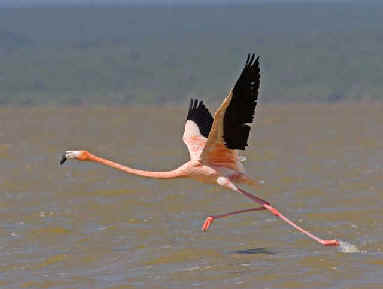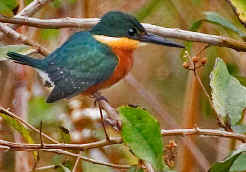
E-mail: font@focusonnature.com
Phone: Toll-free in USA 1-800-721-9986
or 302/529-1876; Fax: 302/529-1085
 |
PO Box 9021,
Wilmington, DE 19809, USA E-mail: font@focusonnature.com Phone: Toll-free in USA 1-800-721-9986 or 302/529-1876; Fax: 302/529-1085 |
THE
FOCUS ON NATURE TOUR IN MEXICO
June 2008
Mostly in the
Yucatan, also Cozumel Island

The American Flamingo
can be seen in large numbers along the north Yucatan coast,
as they were during the FONT tour there in June 2008.
Links:
List
of Birds & Other Wildlife during our Mexico Tour - June 2008
List of Birds of the Yucatan Region of Mexico (with some photos)
Upcoming FONT Birding & Nature Tours in Mexico & Central America
The following narrative was written by Armas Hill, leader of the tour:
As noted in the
above title, the FONT June 17-26, 2008
Mexico Tour was mostly on the Yucatan
Peninsula, with a visit also to nearby Cozumel Island,
12 miles offshore.
The wording is "mostly on the Yucatan Peninsula" in that we also went
a few miles further south, into some wonderful, recently-opened, remote areas
that are still quite wild - close to the Mexican borders
with Guatemala and Belize.
Most notable of those southerly areas was Calakmul.
Not only is it remote, it's a not-often visited site of Mayan ruins, comparable
with those at Tikal
in Guatemala.
And, more than just Mayan ruins, Calakmul is also a vast reserve known as a biosphere.
When standing atop the
highest temple there, one sees to the horizon in all directions only a sea
of green foliage of forest.
Calakmul was one of 4 biospheres that we visited
during our tour, during which we found over 200 species of birds.
And there could have been more species yet as the Yucatan is a bird-rich area.
Of course, birds present in the month of June were mostly the residents.
Migrants from the north were mostly missing (with a couple exceptions).
There were a few migrants from the south (3) that come from South America to the
Yucatan to breed: 2 species of flycatchers and a vireo (to be noted further
along in this narrative).
But even without the many migrants that winter in the Yucatan, we still found,
in June '08, many birds - as noted, 200-plus species.
And a number of them were interesting, in that they were endemics and
specialties.
The Yucatan has a number of interesting species and subspecies as the
isolated region has evolved, due to a number of factors, to have its own
distinctive flora and fauna.
Thus, it has 14 endemic species of birds, and
almost 100 endemic subspecies.
The bird-life of nearby Cozumel Island is
also interesting. 3 endemic species and about 15 endemic subspecies occur
there.
Among our favorite birds of the June 2008 Mexico Tour were:
the endemic Yucatan Wren (the
last of the Yucatan species to be described, in 1934),
and the
nearly-endemic Mexican Sheartail.
That hummingbird has a very
interesting range. Like the Yucatan, or Black-throated, Bobwhite,
it is restricted to the Yucatan all but for a small isolated population
elsewhere. But on the Yucatan, it only occurs in the north, near the coast,
where its range has only the width of just over a kilometer!
However, even with all of the endemic & nearly-endemics notwithstanding, the bird that
we liked the most during our tour was one with an extensive range in Central
& South America.
But we saw it so well!
And it stayed - just a few feet from
us.
It was the little and brightly-colored American Pygmy Kingfisher, by
a small marsh in the forest in that wild area of Calakmul.

American Pygmy Kingfisher
Shifting from a
little bird, to looking at the bird picture, in part, a reason for our finding
so many birds during our Jun '08 Mexico Tour was because there are many birds, to be found,
in that area where we were.
Overall, about
540 species of birds, belonging to about 75
families, have been found in the Yucatan
region of Mexico, within the 3 states of
Campeche, Quintana Roo, and Yucatan.
Of these, nearly 60 are considered vagrants and occasional visitors. And so, simply
put, there are about 480 bird species that regularly occur in Mexico's Yucatan.
The total of about 540 is approximately half of all the bird species that
have been found in Mexico, (over 1,000), and nearly 60% of the number of bird species that
have been noted in the United States and Canada.
The diverse bird fauna of the Yucatan
is measurably enriched by the peninsula serving as a major thoroughfare for migratory
birds as they head south in the fall and north in the spring. Many of
those birds spread themselves out during the winter from southern Mexico to
South America.
In all, nearly 220 bird species from
the north have been noted in the Yucatan.
About 35 of them have been vagrants or only occasional visitors.
But nearly 130 of them over-winter in the Yucatan on a regular basis every year.
(A
few of these birds, such as the Blue-gray Gnatcatcher, also have a
year-round population that is resident in the Yucatan.)
Another group of northern migrants, numbering about 55
species, are predominantly transients, traveling through the Yucatan
Peninsula, as they rest and refuel before continuing on their journey.
Again, here, there are a few exceptions, as small populations of some of these
spend the winter, while 2 species maintain small Yucatan breeding populations
during the summer.
The high number of vagrants to the region is largely due to the combination of
tropical storms and weather systems known as "northers" that occur
during the peak of the fall migration in September and October. Those weather
conditions can blow some birds off their normal course.
There are also some unique, but regular, summer avian
visitors to the Yucatan region from
the Caribbean area, including Sooty and
Bridled Terns, Brown Noddy, and White-crowned Pigeon. They nest on
offshore islands and atolls.
Other summer visitors to the Yucatan include
the two flycatchers and the vireo that were noted at the beginning
of this narrative.
The Flycatchers are the Piratic and the Sulphur-bellied.
The Vireo is the Yellow-green.
These species fly north from South America to nest during the northern hemisphere's spring and summer
months.
As also noted, the Yucatan
region has a nice number of endemic bird
species (14, to be listed in the text that follows) and
endemic subspecies (almost 100!).
This endemism is due to the area's relatively late emergence from the sea
and then isolation from the interior of the country.
Nearly endemic to the Yucatan are two bird species that are, for the most part,
confined to the Yucatan Peninsula, but with
small disjunct populations elsewhere.
These two birds are the Yucatan Bobwhite and a most interesting hummingbird
known as the Mexican Sheartail. (There will be more about these 2 species
follows here in this narrative.)
When referring to the distribution of the Yucatan region's unique fauna, it is
sometimes necessary to include part of the Peten region in northern Guatemala,
and parts of nearby Belize, as some characteristic Yucatan wildlife occurs there.
Just a dozen miles offshore from the northeast coast of the Yucatan, is Cozumel
Island, which is very interesting for its own fauna & flora,
with even more endemism.
The 3 endemic species of birds found only on
that small island are:
the Cozumel Emerald (formerly part of the Fork-tailed Emerald,
with the male having the longest forked tail of the 5 former subspecies, now
species, that occur throughout Central America),
the Cozumel Vireo (with its cinnamon cheeks and sides),
and the rarely-seen, and critically endangered Cozumel Thrasher.
Cozumel Island is also home to a Caribbean
bird species that occurs nowhere else in Mexico, the Western Spindalis, which occurs nowhere
else in Mexico. The uncommon subspecies of that bird on Cozumel is endemic to
the island.
As elsewhere on a number of Caribbean islands, the Smooth-billed Ani has occurred
for a long time on Cozumel. From there, however, it has recently spread to the Yucatan mainland, where it is now along the coast, south of Puerto
Morelos.
(We
saw the species, during our June '08 FONT tour, just south of Tulum.)
Elsewhere in Mexico, Anis are the Groove-billed.
A number of interesting endemic subspecies of birds occur on Cozumel,
including:
a distinctive form of the large Great Curassow,
and a small
version of the Roadside Hawk.
The curassow is critically endangered; the hawk is threatened.
Other interesting endemic subspecies on Cozumel Island include:
the "Cozumel Wren" (a notably different form of the House
Wren),
the "Golden Warbler" (conspecific with the Yellow
Warbler, but with the male sporting a rufous cap),
and unique races of the Rufous-browed Peppershrike, and the Blue-gray
Gnatcatcher.
The last of these subspecies, the gnatcatcher, duskier that others of its ilk,
was described in 1926 by Ludlow Griscom, a well-known birder/ornithologist from
Massachusetts.
The rare local Cozumel race of the Great Curassow (referred to a moment
ago) is also named after Mr. Griscom, "Crax r.
griscomi". It, by the way, is the only subspecies of that curassow,
other than the nominate in Central America.
Even more endemic subspecies are on little Cozumel Island, including those
of these:
Rose-throated Tanager (uncommon),
Golden-fronted and Yucatan Woodpeckers,
Bright-rumped Attila,
Yucatan Flycatcher,
Northern Cardinal,
and the Black Catbird.
That of the Black Catbird was only recently described as such, just a few
years ago.
The Cozumel subspecies of the Yellow-faced
Grassquit and the Bananaquit are only on that island and on the
nearby, smaller Holbox Island.
That subspecies of the Bananaquit has also, in recent years, been found
along the Quintana Roo coast (that is,
the eastern coast of the Yucatan Peninsula), as well as on northern offshore cayes
(or islands) in Belize, where it was unknown
prior to the 1980s.
In all, the total number of bird species known to have occurred on Cozumel
Island is well over 200.
A complete listing is elsewhere in this web-site: COZUMEL
BIRDS
In addition to the 3 endemic bird species just noted as being on Cozumel
Island (the Emerald, Vireo, & Thrasher),
the other 11 endemic birds of the Yucatan
region are:
Ocellated Turkey
Yucatan Amazon (or Parrot)
Yucatan Poorwill
Yucatan Nightjar
Yucatan (or Red-vented) Woodpecker
Yucatan Flycatcher (in the Myiarchus genus)
Yucatan Jay (with its bright, yellow legs)
Yucatan Wren (described as a species only as recently as 1934)
Black Catbird
Rose-throated Tanager
Orange Oriole.
To this list, the Ridgway's Rough-winged Swallow could be added, as it is
a "quasi-endemic" of the Yucatan region, being a resident that breeds
in that area, as well as in nearby Belize, northern Guatemala, and slightly
further west in Mexico.
Mention has been made here, a couple paragraphs ago, to the Yucatan (or
Black-throated) Bobwhite and to a hummingbird,
endemic to Mexico, called the Mexican Sheartail.
Its name not withstanding, the Bobwhite is not truly endemic to the
Yucatan, as a few disjunct populations have been found, including one in
Honduras.
The Mexican Sheartail is another such species, with another separated,
and in fact very isolated, population. In addition to being along the north
coast of the Yucatan peninsula, close to the sea, it is also known to be in just
a very small area, hundreds of kilometers to the west, in central Veracruz.
The northern Yucatan population of the Mexican Sheartail is found
exclusively in a very narrow range that's only about 1 kilometer wide - mainly
between mangroves and tropical deciduous forest. It has also been found to breed
in gardens. That population of the species is considered "threatened".
The smaller Veracruz population of the Mexican Sheartail is in
undisturbed, dry deciduous forest and overgrazed habitats at about 25 kilometers
inland. That population is critically endangered.
In the northern Yucatan, the Mexican Sheartail has been observed feeding
at flowers of Ipomoea, Justicia, and Helicteres guazumaefolia, and its diet is
supplemented by small anthropods. The bird is often close to the ground.
Just offshore from the narrow range of the Mexican Sheartail in the northern
Yucatan, there are flamingos, as many as thousands of them.
They nest in the late spring and summer in and near the Rio
Lagartos Special Biosphere Reserve. Many of them spend the winter a
couple hundred or so kilometers to the west, as the flamingo would fly, at the Rio
Celestun Special Bioshpere Reserve.
These birds have long attracted notice. Flamingos, in all likelihood this
population, were recorded as being prominent members of the Aztec Emperor
Montezuma's menagerie.
Although there are still thousands of them, conservationists take a special
interest in the flamingos because their specialized habits make them
vulnerable to drastic population declines. Their numbers have fluctuated in
recent years.
The method by which they feed, that is dredging the bottom sediment of shallow
lagoons and estuaries, makes the birds susceptible to toxics in the mud, such as
the lead from leadshot used in shotguns.
The flamingos feed only in areas with very specific water conditions,
which can change abruptly. That happened in 1988 when Hurricane Gilbert damaged
some of the flamingos' prime feeding areas, causing them to seek other
sites. Many died. Also, their nests on mudflats, are easy targets for egg and
chick predators, such as raccoons and foxes.
Yet, the Mexican flamingo population is considered fairly healthy, having
risen from a low of between 8,000 and 12,000 individuals in the 1970s (when
the Rio Lagartos & Rio Celestun Reserves were created), to about 26,000
birds in the mid-1980s. Hurricane Gilbert (as noted, in 1988) was a
setback to this population growth, but the flamingos have since recovered.
During the FONT tour in June 2008, we saw a number of flamingos. With
adults, there were young birds.

Armas Hill (left) &
Fred Lesser (right)
during the June 2008 FONT tour in the Yucatan of Mexico
before seeing the flamingos - the real flamingos.
Fred has participated on many FONT tours over the years.
At the edge of one flock of
flamingos, a "Great White Heron" was
walking in the shallow water. That bird is actually a white morph of the Great
Blue Heron, Ardea herodias occidentalis.
In that area of estuaries, mangroves, mudflats, and sandbars, we saw many
waterbirds. Long-legged waders, in addition to American Flamingos and Great
Blue Herons (both dark birds & the single one), included:
Roseate Spoonbill, White Ibis, Little Blue and Tricolored
Herons, Reddish Egrets (white birds), other white Egrets: the Snowy
and the Great; also Green Heron, Yellow-crowned Night heron,
Boat-billed Heron, Bare-throated Tiger Heron, Magnificent Frigatebirds, Brown
Pelicans, a flock (even in June) of American White Pelicans,
Neotropic Cormorants, Anhinga, Laughing Gulls, and 4 species of Terns:
Gull-billed, Sandwich, Royal, and Least. Also (even In June), we
saw 10 species of shorebirds, including the Snowy Plover.
We learned that just a couple weeks prior to our being there, the Jabirus,
that nested in the area, departed. They had raised 2 young, during their 4th
year of year of nesting there. Yes, birds beget birds. Many bird species in that
region are common. Jabirus, there, and anywhere in Mexico, are rare.
On sandbars where we saw terns, we learned that at another time of the
year, there are gulls. And, among them, we were told, both Lesser
Black-backed Gulls and Kelp Gulls have been seen together during
recent years. That's interesting, of course, as Kelp Gulls are
normally in the Southern Hemisphere, and the Lesser Black-backed Gull
has, over time, been primarily a European breeding bird, wintering south to
Africa.
It's also notable that the affinity that the coastal vegetation of the Yucatan
Peninsula has with the Caribbean region
provides habitat for a number of birds found nowhere else in Mexico, These
include: Zenaida Dove, White-crowned Pigeon, Caribbean Elaenia, Yucatan Vireo,
and Western Spindalis.
To that list, now, a bird that has recently arrived, can be added, the Shiny
Cowbird.
Another bird of the Yucatan with an unusual distribution is the White-lored Gnatcatcher,
found only along the north coast in the state of Yucatan. Otherwise, it inhabits
parts of the west coast of Mexico, with most of its range further south in
Central America.
Generally, most of these birds occur in areas of the Yucatan
region that are protected. There are approximately 40
natural protected areas in the region, covering
almost 9 million acres. These places include both terrestrial and
marine habitats, and include both public and private reserves.
Additionally, 24 sites on the Yucatan Peninsula have been designated as "Important
Bird Areas" (IBAs).
Also worth a mention, of course, are the 5 Biosphere
Reserves in the Yucatan that have been established by the UN
Educational, Scientific, & Cultural organization for both the protection of
the natural areas and the conservation of land for local people.
All but 17 of the bird species that are included in the "Yucatan list"
are to be found within natural protected areas in the region. And that's a
lot of birds!
Here, in order, are
the "Top Birds" of our June 2008
Yucatan, Mexico Tour, as voted by the participants:
1 - American Pygmy Kingfisher
(the number #1 bird, as it was so
cooperative, when it sat still, tamely, so close to us)
2 - Yucatan Jay
(with wonderful, bright yellow legs!)
3 - Slaty-breasted Tinamou
(seen walking across the road, in front
of us)
4 - Black Catbird
(a nice regional specialty, as it was
common & easy to see)
5 - Great Curassow
(also seen walking across the road in
front of us - the same road as was the tinamou)
6 - Turquoise-browed Motmot
(a bird filled with color - once we saw
a bare tree filled with these birds, with about a dozen on the branches)
7 - Cozumel Vireo
(a nifty endemic to the island, with
cinnamon cheeks & sides)
8 - Orange Oriole
(one of a number of bright,
orange-colorful orioles - we saw many such colorful birds)
9 - Yucatan Nightjar (and other "goatsuckers")
(along one dirt road, one night, 3 of
these species were seen; the endemic Yucatan Nightjar was so very well)
10 - Least Grebe
(like small toys close to our feet, as
they were on the water at the edge of a pond - so tame those birds were)